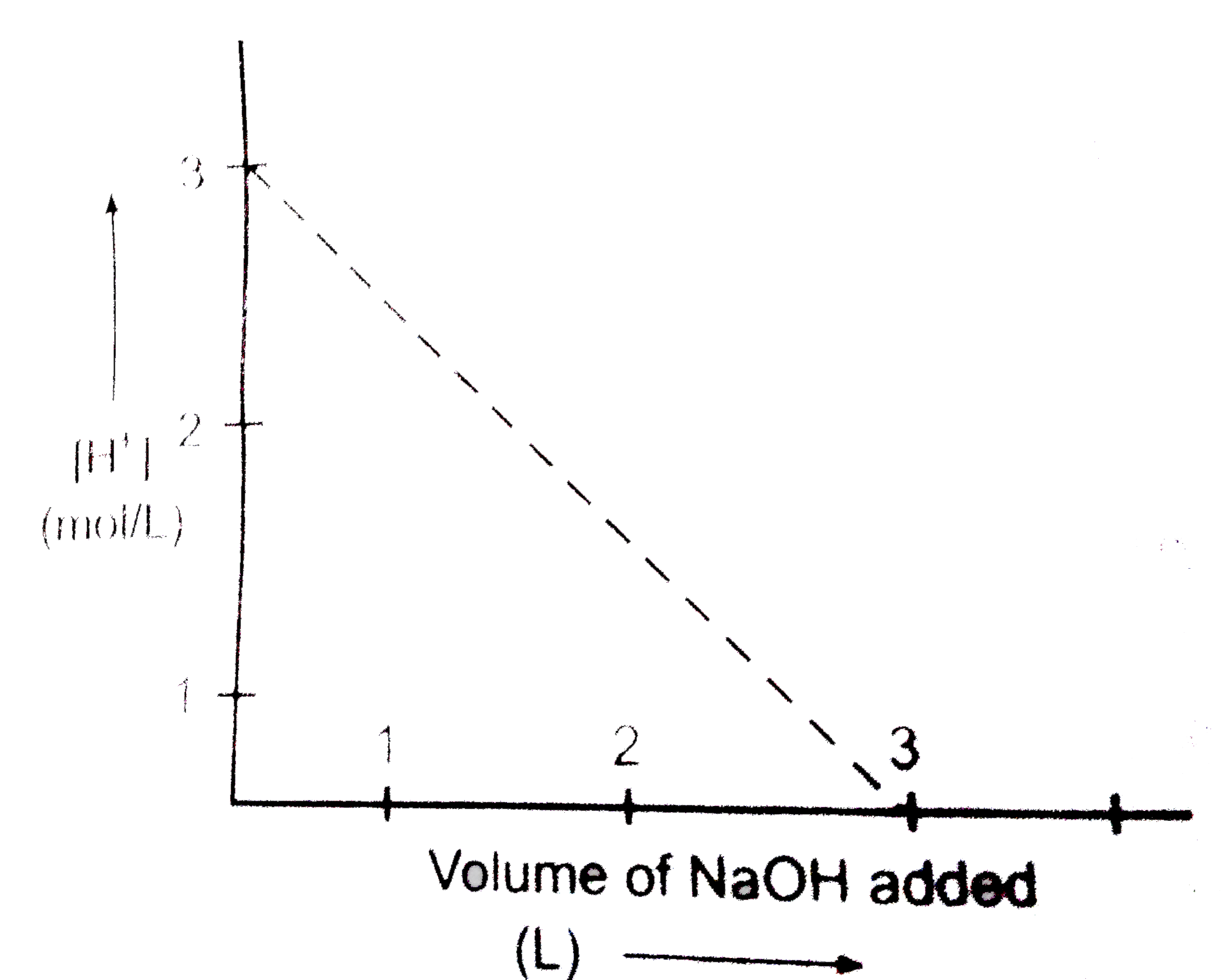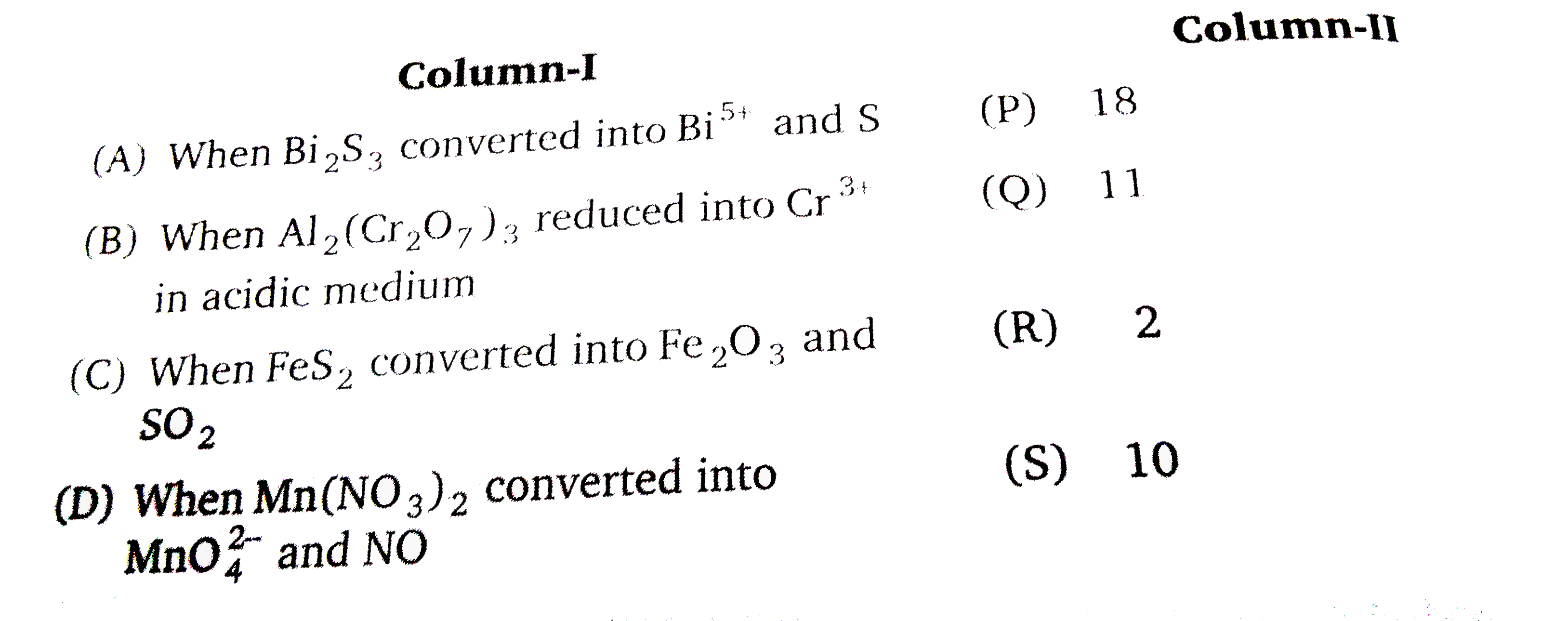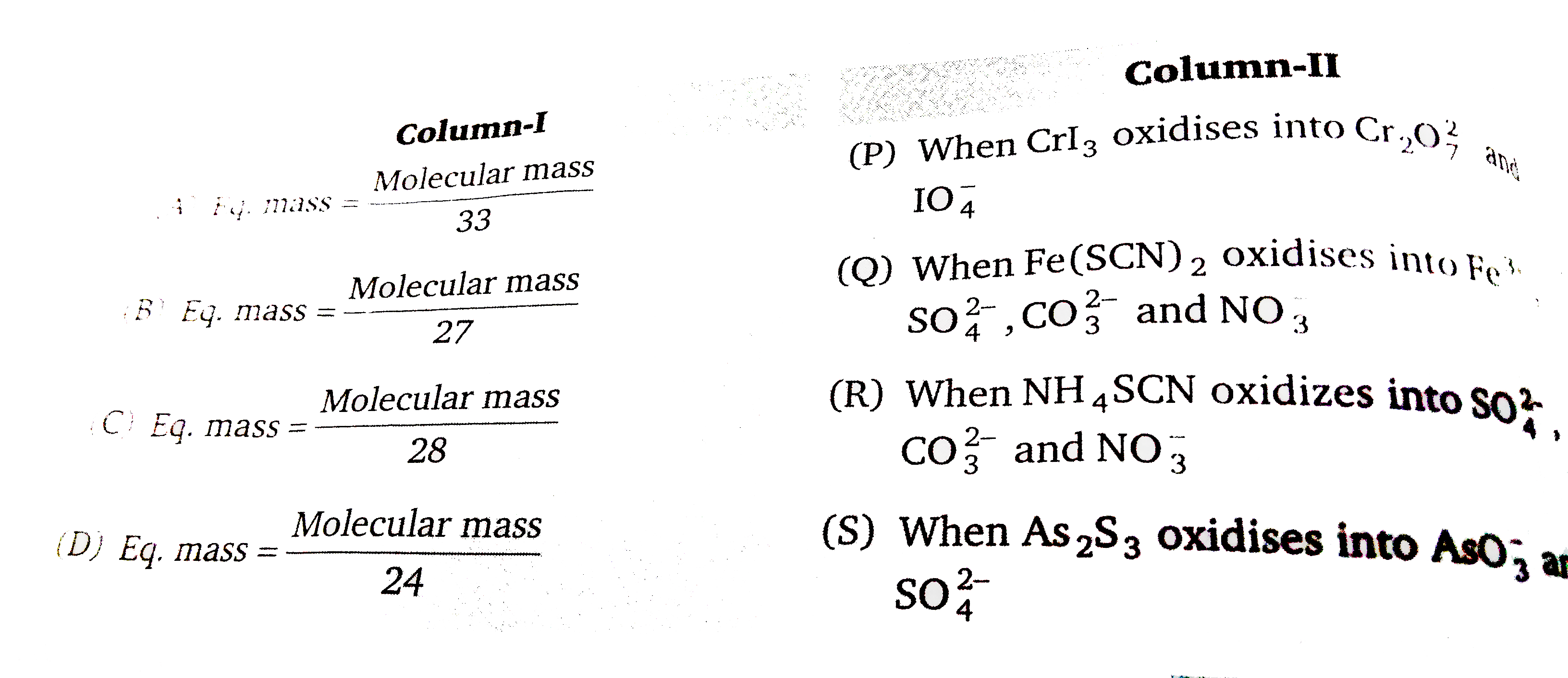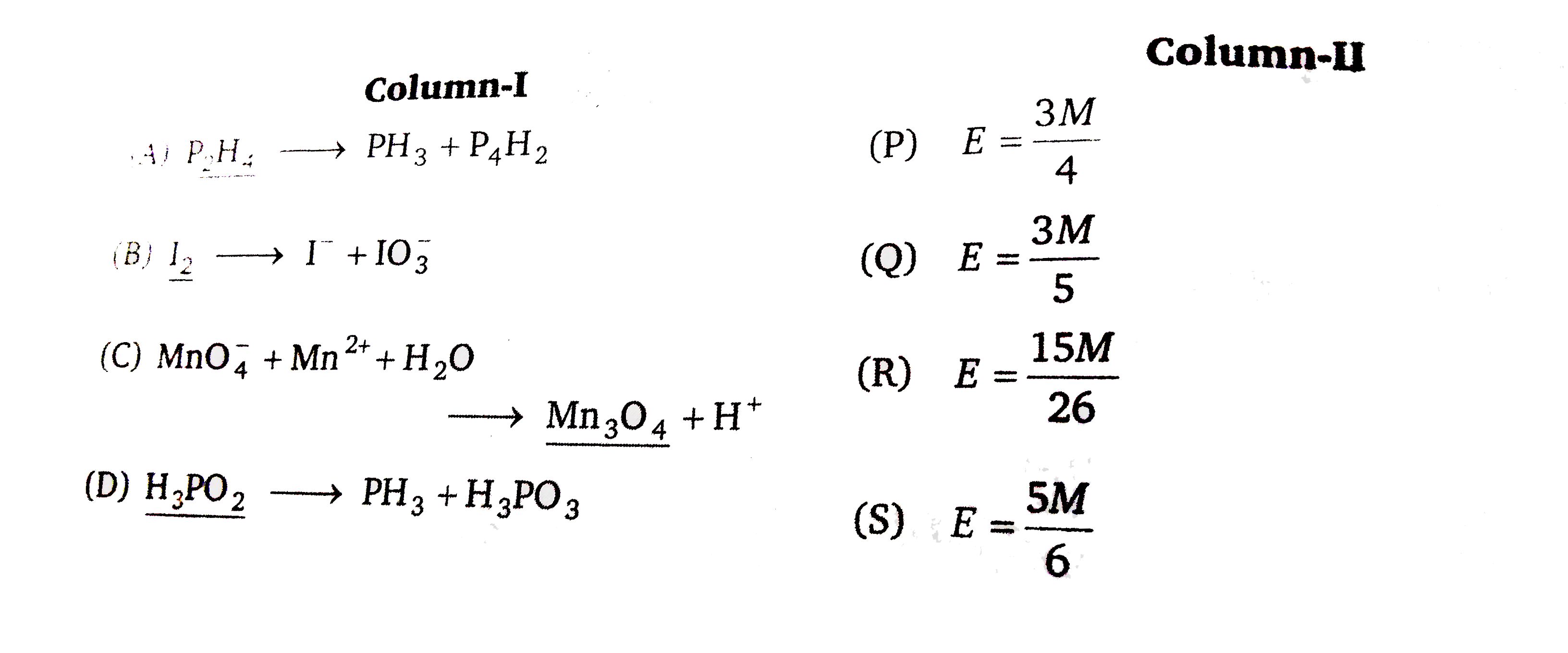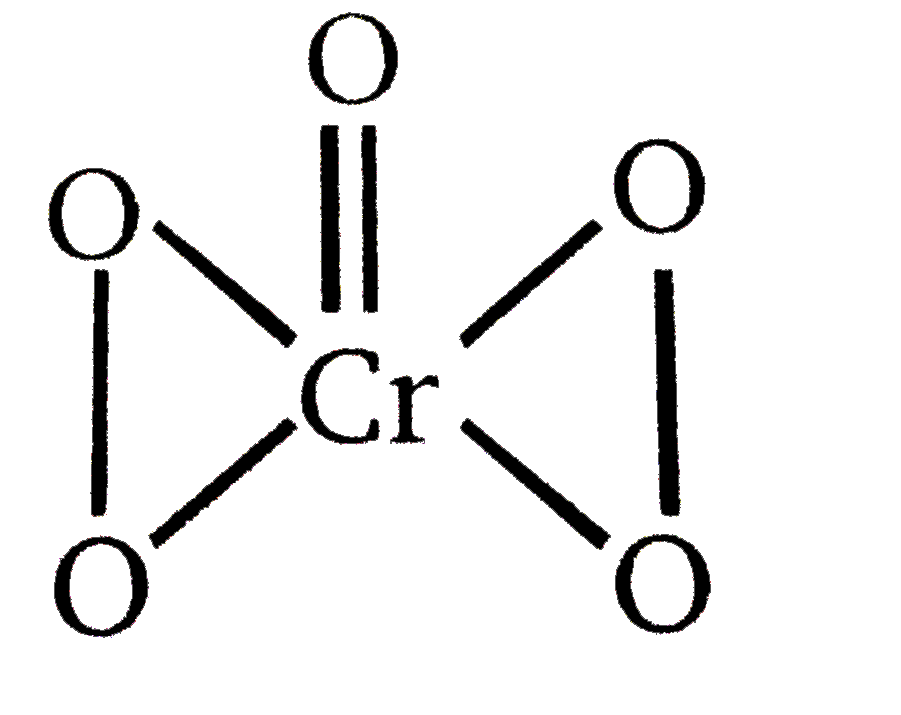Level 3 - Subjective Problems from NARENDRA AWASTHI STOICHIOMETRY for Class 11
| Class 11 | CHEMISTRY |
| Chapter | STOICHIOMETRY |
| NARENDRA AWASTHI | Level 3 - Subjective Problems |
| Medium | English |
| Academic Year | 2023-2024 |
Question 65
2.0 g of a sample contains mixture of SiO2 and Fe2O3. On very strong heating , it leaves a residue weighing 1.96g. The reaction responsible for loss of mass is given below .
Fe2O3(s)→Fe3O4(s)+O2(g), (unbalance equation) lt brgt What is the precentage by mass of SiO2 in original sample ?View SolutionQuestion 73
9 moles of "D" and 14 moles of E are allowed to react in a closed vessel according to given reactions. Calculate number of moles of B formed in the end of reaction, if 4 moles of G are present in reaction vessel. (percentage yield of reaction is mentioned in the reaction) Step -1 3D+4E80%→5C+A Step-2 3C+5G50%→6B+FView SolutionQuestion 74
The chief ore of Zn is the sulphide , ZnS. The are is concentrated by froth floation process and then heated in air to convert Zns to Zno.
2ZnS+30280%−−→2ZnO+2SO2
ZnO+H2SO4100%−−→ZnSO4+H2
2ZnSO4+2H2O80%−−→2Zn+2H2SO4+O2
The number of moles of ZnS required for producing 2 moles of Zn will be:View SolutionQuestion 107
20mL of a mixture of CO and H2 were mixed excess of O2 and exploded & cooled. There was a volume contraction of 23mL. All volume measurements corresponds to room temperature (27∘C) and one atmospheric pressure. Determine the volume ratio (V1:V2ofCo anf H2 in the original mixture .View SolutionQuestion 110
40 ml gaseous mixture of CO, CH4 and Ne was exploded with 10 ml of oxygen. On cooling, the gases occupied 36.5 ml. After treatment with KOH the volume reduced by 9 ml and again on treatment with alkaline pyrogallol, the volume further reduced, percentage of CH4 in the original mixture is View SolutionQuestion 143
The equivalent weights of oxidising and reducing agents can be calculated by the number of electrons gained or lost. The equivalent weight of an oxidising agent is the number of parts by weight of the substance which gains one electron. Thus, it is equal to the molecular weight of the substance divided by the number of electrons gained in the balanced chemical equation. Similarly, equivalent weight of a reducing agent is equal to the molecular weight divided by the number of electrons lost as represented in the balanced chemical equation
The equivalent weght of As2,S3 in the following reaction
As2S3+H++NO−3→NO+H2O+AsO3−4+SO2−4 is related to its molecular weight as View SolutionQuestion 155
H2O2 is used as bleaching reagent because on dissociation it gives oxygen
(H2O2→H2O+12O2)
"Chachi420" used H2O2 solution to bleach her hair and she required 2.24LO2 gas at 1atm and 273K. She has a H2O2 solution labelled '5.6V' then what volume of such solution must she required to bleach her hair?View SolutionQuestion 170
The concentration of bivalent lead ions in a sample of polluted of polluted water that aslo contains nitrate ions is determined by adding solid sodium sulphate (M=142) to exactly 500mL water. Calculate the molarity of lead ions if 0.355g is sodium sulphate was nedded for complete precipitation of lead ions as sulphate.View SolutionQuestion 179
Stannous sulphate (SnSO4) and potassium permanganate are used as oxidising agents in acidic medium for oxidation of ferrrous ammnium sulphate to ferric sulphate. The ration of number of moles of stannous sulphate required per mole of ferrous ammonium sulphate to the number of moles of KMnO4 required per mole of ferrous ammonium sulphate, is: View SolutionQuestion 184
There are two types of iodine titrations (a) Iodometric & (b) Iodimetric, Iodometric method is indirect method of I2 estimation. Any oxidant which liberates I2 from KI solution, the liberated iodine is estimated by titrating it with Na2S2O3 solution as : I2+2Na2S2O3→2NaI+Na2S4O6
100 mL of .x. M K2Cr2O7 solution is added to excess of KI solution in acidic medium. The liberated iodine required 50 mL of 0.1N Na2S2O3 solution. The value of x is View SolutionQuestion 191
1gram of a sample of CaCO3 was strongly heated and the CO2 liberated was absorbed in 100mL of 0.5 M NaOH solution. Assuming 90% purity for the sample, how many mL of 0.5M HCl would be required to react with the resulting solution to reach the end point inpresence of phenolphthaein?View SolutionQuestion 202
6.2 g of a sample containing NaHCO3, NaHCO3 and non -volatiale inert impurity on gentle heating loses 5% of its mass due to reaction 2NaHCO3→Na2CO3+H2O+CO2. Residue is dissolved in water and formed 100 mL solution and its 10 mL portion requires 7.5 mL of 0.2 M aqueous solution of BaCl2 for complete precipitation of carbonates.
Determine mass (in gram) of Na2CO3 in the original sample .View SolutionQuestion 203
Nitric acid can be produced from NH3 in three step process
I) 4NH3(g)+5O2(g)→4NO(g)+6H2O(g) II) 2NO(g)+O2(g)→2NO2(g)
III) 3NO2(g)+H2O(l)→2HNO3(aq)+NO(g)
% yield of I, II, III reaction are respectively 50%, 60% and 80%. Then how much volume of NH3(g) at STP is required to produce 2.25 gm of HNO3. View SolutionQuestion 206
A 1.0g sample of a pure organic compound cotaining chlorine is fused with Na2O2 to convert chlorine to NaCl. The sample is then dissolved in water, and the chloride precipitated with AgNO3, giving 1.96 g of AgCl. If the molecular mass of organic compound is 147, how many chlorine does each molecule contain ? View SolutionQuestion 209
Urea(H2NCONH2) is manufactured by passing CO2(g) through ammonia solution followed by crystallization. For the above reaction is prepared by combustion of hydrocarbons. If combustion of 236 kg of a saturated hydrocarbon (CnH2n+2) produces as much CO2 as required for production of 999.6 kg urea then molecular formula of hydrocarbon is:View SolutionQuestion 210
11.6 g of an organic compound having formula (CnH2n+2) is burnt in excess of O2(g) initially taken in a 22.41 litre steel vessel. Reaction the gaseous mixture was at 273 K with pressure reading 2 atm. After complete complete combustion and loss of considerable amount of heat, the mixture of product and excess of O2 had a temperature of 546 K and 4.6 atm pressure. The formula of organic compound is :View SolutionQuestion 211
H2O2+2KI40% yield−−−−−→I2+2KOH
H2O2+2KMnO4+3H2SO450% yield −−−−−→K2SO4+2MnSO4+3O2+4H2O
150 ml of H2O2 sample was divided into two parts. First part was treated with KI and Formed KOH required 200 ml. of M/2H2SO4 for neutralisation.Other part was trated with KMnO4 yielding 6.74 litre of O2 at STP.Using % yield indicated find volume stregth of H2O2 sample used.View SolutionQuestion 215
A silver coin weighing 11.34 g was dissolved in nitric acid When sodium chloride was added to the solution all the silver (present as AgNO3) precipitated as silver chloride. The mass of the precipitated silver chloride was 14.35 g. Calculate the percentage of silver in the coin. View SolutionQuestion 222
A mixture of FeO and Fe2O3 is completely reacted with 100 mL of 0.25 M acidified KMnO4 solution. The resultant solution was then treated with Zn dust which converted Fe3+ of the solution to Fe2+.The Fe2+ required 1000 mL of 0.10 MK2Cr2O7 solution. Find out the weight % Fe2O3 in the mixture. View SolutionQuestion 223
To a 10mL, 1M aqueous solution of Br2, excess of NaOH is added so that all Br2 is disproportionated to Br− and BrO−3. The resulting solution is free from Br−, by extraction and excess of OH− neutralised by acidifying the solution. The resulting solution is suffcient to react with 2 g of impure CaC2O4(M= 128g/mol) sample. The % purity of oxalate sample is : View SolutionQuestion 224
0.10g of a sample containing CuCo3 and some inert impurity was dissolved in dilute sulphuric acid and volume made up to 50mL. This solution was added into 50mL of 0.04MKI solution where copper precipitates as CuIandI− is oxidized into I−3. A 10mL portion of this solution is taken for analysis, filtered and made up free I−3 and then treated with excess of acidic permanganate solution. Liberated iodine required 20mL of 2.5mM sodium thiosulphate solution to reach the end point . Determine mass percentage of CuCO3 in the original sample.View SolutionQuestion 226
An impure sample of sodium oxalate (Na2C2O4 weighing 0.20 g is dissolved in aqueous solution of H2SO4) and solution is titrated at 70∘C,requiring 45 mL of 0.02 M KMnO4 solution. The end point is overrun, and back titration in carried out with 10 mL of 0.1 M oxalic acid solution.Find the purity of Na2C2O4 in sample: View SolutionQuestion 229
A mixture of H2SO4 and H2C2O4 (oxalic acid ) and some inert impurity weighing 3.185 g was dissolved in water and the solution made up to 1litre. 10 mL of this solution required 3 mL of 0.1 N NaOH for complete neutralization. In another experiment 100 mL of the same solution in hot condition required 4 mL of 0.02 M KMnO4 solution for complete reaction. The mass % of H2SO4 in the mixture was: View SolutionQuestion 232
Oleum is considered as a solution of SO3 in H2SO4, which is obtained by passing SO3 in solution of H2SO4 When 100 g sample of oleum is diluted with desired mass of H2O then the total mass of H2SO4 obtained after dilution is known is known as % labelling in oleum.
For example, a oleum bottle labelled as '109%H2SO4' means the 109 g total mass of pure H2SO4 will be formed when 100 g of oleum is diluted by 9 g of H2O which combines with all the free SO3 present in oleum to form H2SO4 as SO3+H2O→H2SO4
What is the % of free SO3 in an oleum that is labelled as '104.5%H2SO4' ? View SolutionQuestion 233
Oleum is considered as a solution of SO3 in H2SO4, which is obtained by passing SO3 in solution of H2SO4 When 100 g sample of oleum is diluted with desired mass of H2O then the total mass of H2SO4 obtained after dilution is known is known as % labelling in oleum.
For example, a oleum bottle labelled as '019%H2SO4' means the 109 g total mass of pure H2SO4 will be formed when 100 g of oleum is diluted by 9 g of H2O which combines with all the free SO3 present in oleum to form H2SO4 as SO3+H2O→H2SO4
9.0 g water is added into oleum sample lablled as "112%" H2SO4 then the amount of free SO3remaining in the solution is : (STP=1 atm and 273 K)View SolutionQuestion 234
Oleum is considered as a solution of SO3 in H2SO4, which is obtained by passing SO3 in solution of H2SO4 When 100 g sample of oleum is diluted with desired mass of H2O then the total mass of H2SO4 obtained after dilution is known is known as % labelling in oleum.
For example, a oleum bottle labelled as '109%H2SO4' means the 109 g total mass of pure H2SO4 will be formed when 100 g of oleum is diluted by 9 g of H2O which combines with all the free SO3 present in oleum to form H2SO4 as SO3+H2O→H2SO4
If excess water is added into a bottle sample labelled as "112%H2SO4" and is reacted with 5.3 g NaCO3 then find the volume of CO2 evolved at 1 atm pressure and 300 K temperature after the completion of the reaction :View SolutionQuestion 235
Oleum is considered as a solution of SO3 in H2SO4, which is obtained by passing SO3 in solution of H2SO4 When 100 g sample of oleum is diluted with desired mass of H2O then the total mass of H2SO4 obtained after dilution is known is known as % labelling in oleum.
For example, a oleum bottle labelled as '109%H2SO4' means the 109 g total mass of pure H2SO4 will be formed when 100 g of oleum is diluted by 9 g of H2O which combines with all the free SO3 present in oleum to form H2SO4 as SO3+H2O→H2SO4
1 g of oleum sample is diluted with water. The solution required 54 mL of 0.4 N NaOH for complete neutralization. The % free SO3 in the sample is : View SolutionQuestion 236
The strength of H2O2 is expressed in several ways like molarity, normality,% (w/V), volume strength, etc. The strength of "10 V" means 1 volume of H2O2 on decomposition gives 10 volumes of oxygen at 1 atm and 273 K or 1 litre of H2O2gives 10 litre of O2 at 1 atm and 273 K The decomposition of H2O2 is shown as under :
H2O2(aq)→H2O(l)+12O2(g)
H2O2 can acts as oxidising as well as reducing agent. As oxidizing agent H2O2 is converted into H2O and as reducing agent H2O2 is converted into O2. For both cases its n-factor is 2. ∴Normality ofH2O2 " solution " =2× molarity ofH2O2 solution
What is the molarity of "11.2 V" H2O2 ? View SolutionQuestion 237
The strength of H2O2 is expressed in several ways like molarity, normality,% (w/V), volume strength, etc. The strength of "10 V" means 1 volume of H2O2 on decomposition gives 10 volumes of oxygen at 1 atm and 273 K or 1 litre of H2O2gives 10 litre of O2 at 1 atm and 273 K The decomposition of H2O2 is shown as under :
H2O2(aq)→H2O(l)+12O2(g)
H2O2 can acts as oxidising as well as reducing agent. As oxidizing agent H2O2 is converted into H2O and as reducing agent H2O2 is converted into O2. For both cases its n-factor is 2. ∴Normality of H2O2 solution =2×molarity ofH2O2 solution
What is thepercentage strength (%w/V) of "11.2 V" H2O2View SolutionQuestion 238
The strength of H2O2 is expressed in several ways like molarity, normality,% (w/V), volume strength, etc. The strength of "10 V" means 1 volume of H2O2 on decomposition gives 10 volumes of oxygen at 1 atm and 273 K or 1 litre of H2O2gives 10 litre of O2 at 1 atm and 273 K The decomposition of H2O2 is shown as under :
H2O2(aq)→H2O(l)+12O2(g)
H2O2 can acts as oxidising as well as reducing agent. As oxidizing agent H2O2 is converted into H2O and as reducing agent H2O2 is converted into O2. For both cases its n-factor is 2. ∴Normality ofH2O2 "solution" =2×molarity ofH2O2 solution
20mL of H2O2 solution is reacted with 80 mL of 0.05 MKMnO4 "in acidic medium then what is the volume strength of" H2O2 ? View SolutionQuestion 239
The strength of H2O2 is expressed in several ways like molarity, normality,% (w/V), volume strength, etc. The strength of "10 V" means 1 volume of H2O2 on decomposition gives 10 volumes of oxygen at 1 atm and 273 K or 1 litre of H2O2gives 10 litre of O2 at 1 atm and 273 K The decomposition of H2O2 is shown as under :
H2O2(aq)→H2O(l)+12O2(g)
H2O2 can acts as oxidising as well as reducing agent. As oxidizing agent H2O2 is converted into H2O and as reducing agent H2O2 is converted into O2. For both cases its n-factor is 2. ∴Normality ofH2O2 " solution " =2×molarity ofH2O2 solution
40 g Ba(MnO4)2 (mol.mass=375) sample containing some inert impurities in acidic medium completely reacts with 125 mL of "33.6 V" of H2O2. What is the percentage purity of the sample ? View SolutionQuestion 240
A water is said to be soft water if it produces sufficient foam with the soap and water that does not produce foam with soap is known as hard water. Hardness has been classified into two types (i)Temporary hardness (ii) Permanent hardness.
Temporary hardness is due to presence of calcium and magnesium bicarbonate. It is simply removed by boiling as
Ca(HCO3)2Δ−−→CaCO3⏐⏐↓+CO2↑⏐⏐+H2O
Mg(HCO3)2Δ−−→MgCO3⏐⏐↓+CO2↑⏐⏐+H2O
temporary hardness can also be removed by addition of slaked lime, Ca(OH)2
Ca(HCO3)2+Ca(OH)2→2CaCO3⏐↓+2H2O
permanent hardsness is due to presencce of sulphates and chlorides of Ca,Mg,etc. It is removed by washing soda as
CaCl2+Na2CO3→CaCO3↓+2NaCl
CaSO(4)+Na2CO3→CaCO3⏐↓+Na2SO4
Permanent hardness also removed by ion exchange resin process as
2RH+Ca2+→R2Ca+2H+
2ROH+SO2−4→R2SO4+2OH−
The degree of hardness of water is measured in terms of PPm of CaCO3 100 PPm means 100 g of CaCO3 is present in 106 g of H2O. If any other water sample which contain 120 PPm of MgSO4, hardness in terms of CaCO3 is equal to =100 PPm.
What is the mass of Ca(OH)2 required for 10 litre of water remove temporary hardness of 100 PPm due to Ca(HCO3)2 ? View SolutionQuestion 242
A water is said to be soft water if it produces sufficient foam with the soap and water that does not produce foam with soap is known as hard water. Hardness has been classified into two types (i)Temporary hardness (ii) Permanent hardness.
Temporary hardness is due to presence of calcium and magnesium bicarbonate. It is simply removed by boiling as
Ca(HCO3)2Δ−−→CaCO3⏐⏐↓+CO2↑⏐⏐+H2O
Mg(HCO3)2Δ−−→MgCO3⏐⏐↓+CO2↑⏐⏐+H2O
temporary hardness can also be removed by addition of slaked lime, Ca(OH)2
Ca(HCO3)2+Ca(OH)2→2CaCO3⏐↓+2H2O
permanent hardsness is due to presencce of sulphates and chlorides of Ca,Mg,etc. It is removed by washing soda as
CaCl2+Na2CO3→CaCO3↓+2NaCl
CaSO(4)+Na2CO3→CaCO3⏐↓+Na2SO4
Permanent hardness also removed by ion exchange resin process as
2RH+Ca2+→R2Ca+2H+
2ROH+SO2−4→R2SO4+2OH−
The degree of hardness of water is measured in terms of PPm of CaCO3 100 PPm means 100 g of CaCO3 is present in 106 g of H2O. If any other water sample which contain 120 PPm of MgSO4, hardness in terms of CaCO3 is equal to =100 PPm.
What is the mass of Ca(OH)2 required for 10 litre of water remove temporary hardness of 100 PPm due to Ca(HCO3)2 ? View SolutionQuestion 243
"Equivalent mass" =("Molecular mass/Atomic mass" )/("n-factor")
n-factor is very important in redox as well as non-redox reactions. With the help of n-factor we can predict the molar ratio of the reactant species taking part in reactions. The reciprocal of n-factor's ratio of the reactions is the molar ratio of the reactants.
In general n-factor of acid/base is number of moles of H+/OH− furnished per mole of acid/base n-factor of a reactant is number of moles electrons lost or gained per mole of reactant.
Example 1:
(1)In acidic medium : KMnO4(n=5)→Mn2+
(2) In neutral medium : KMnO4(n=3)→Mn2+
(3) In basic medium : KMnO4(n=1)→Mn6+
Example 2 : FeC2O4→Fe3++2CO2
Total number of moles e− lost by 1 mole of FeC2O4
=1+1×2⇒3
n-factor of Ba(MNO4)2 in acidic medium is : View SolutionQuestion 244
"Equivalent mass" =("Molecular mass/Atomic mass" )/("n-factor")
n-factor is very important in redox as well as non-redox reactions.With the help of n-factor we can predict the molar ratio of the reactant species specis taking part in reactions. The reciprocal of n-factor's ratio of the reactions is the molar ratio of the reactants.
In general n-factor of acid/base is number of moles of H+/OH− furnished per mole of acid/base n-factor of a reactant is number of moles electrons lost or gained per mole of reactant.
Example 1:
(1)In acidic medium : KMnO4(n=5)→Mn2+
(2) In neutral medium : KMnO4(n=3)→Mn2+
(3) In basic medium : KMnO4(n=1)→Mn6+
Example 2 : FeC2O4→Fe3++2CO2
Total number of moles e− lost by 1 mole of FeC2O4
=1+1×2⇒3
Consider the following reaction.
H3PO2+NaOH→NaH2PO2+H2O
What is the equivalent mass of H3PO2 ?(mol.Wt.is M)View SolutionQuestion 245
"Equivalent mass" =("Molecular mass/Atomic mass" )/("n-factor")
n-factor is very important in redox as well as non-redox reactions.With the help of n-factor we can predict the molar ratio of the reactant species taking part in reactions. The reciprocal of n-factor's ratio of the reactions is the molar ratio of the reactants.
In general n-factor of acid/base is number of moles of H+/OH− furnished per mole of acid/base n-factor of a reactant is number of moles electrons lost or gained per mole of reactant.
Example 1:
(1)In acidic medium : KMnO4(n=5)→Mn2+
(2) In neutral medium : KMnO4(n=3)→Mn2+
(3) In basic medium : KMnO4(n=1)→Mn6+
Example 2 : FeC2O4→Fe3++2CO2
Total number of moles e− lost by 1 mole of FeC2O4
=1+1×2⇒3
For the reaction, O(molar mass=M)→Fe2O3 what is the eq. mass of fe0.95O ?View SolutionQuestion 246
"Equivalent mass" =("Molecular mass/Atomic mass" )/("n-factor")
n-factor is very important in redox as well as non-redox reactions.With the help of n-factor we can predict the molar ratio of the reactant species specis taking part in reactions. The reciprocal of n-factor's ratio of the reactions is the molar ratio of the reactants.
In general n-factor of acid/base is number of moles of H+/OH− furnished per mole of acid/base n-factor of a reactant is number of moles electrons lost or gained per mole of reactant.
Example 1:
(1)In acidic medium : KMnO4(n=5)→Mn2+
(2) In neutral medium : KMnO4(n=3)→Mn2+
(3) In basic medium : KMnO4(n=1)→Mn6+
Example 2 : FeC2O4→Fe3++2CO2
Total number of moles e− lost by 1 mole of FeC2O4
=1+1×2⇒3
In the reaction, xVO+yFe2O3→FeO+V2O5 what is the value of x and y respectively?View SolutionQuestion 272
A sample of raw material contain NaNO3. It contains some NaIO3 also. The NaIO3 can be used as a source of iodine, produced in the following reactions:
IO−3+HSO−3→I−+SO−4...................(1)
I−+IO−3→I2+H2O............(2)
One litre of sample solution containing 396 g NaIO3 is treated with stoichiometric quantity of NaHSO3. Now a substantial amount of solution is added to reaction mixture to bring about the reaction (2).
 View Solution
View SolutionQuestion 292
N2(g) reacts with H2(g) in either of the following ways depending upon supply of H2(g) :
N2(g)+H2(g)→N2H2(l)
N2(g)+2H2(g)→N2H4(g)
If 5 L N2(g) and 3 L H2(g) are taken initially (at same temperature and pressure ), calculate the contraction in volume after the reaction (in L ).View SolutionQuestion 300
A mixture contains 1.0 mole each of NaOH,Na2CO3 and NaHCO3. When half of mixture is titrated with HCl ,it required x mole of HCl in presence of phenolphthalein. In another experiment ,half of mixture required y mole of same HCl in presence of methyl orange. Find the value of (x+y).View Solution
All Exercises from NARENDRA AWASTHI Class 11 CHEMISTRY STOICHIOMETRY
- ALL QUESTIONS
- EXERCISE
- LEVEL 1 (Q.1 TO Q.30)
- LEVEL 1 (Q.121 TO Q.150)
- LEVEL 1 (Q.151 TO Q.180)
- LEVEL 1 (Q.181 TO Q.200)
- LEVEL 1 (Q.31 TO Q.60)
- LEVEL 1 (Q.61 TO Q.90)
- LEVEL 1 (Q.91 TO Q.120)
- LEVEL 2 (Q.1 TO Q.30)
- LEVEL 2 (Q.31 TO Q.35)
- LEVEL 3 - ASSERTION - REASON TYPE QUESTIONS
- LEVEL 3 - MATCH THE COLUMN
- LEVEL 3 - ONE OR MORE ANSWERS ARE CORRECT
- LEVEL 3 - PASSAGE
- LEVEL 3 - SUBJECTIVE PROBLEMS
- MATCH THE COLUM-II
- ALL QUESTIONS
- EXERCISE
- LEVEL 1 (Q.1 TO Q.30)
- LEVEL 1 (Q.121 TO Q.150)
- LEVEL 1 (Q.151 TO Q.180)
- LEVEL 1 (Q.181 TO Q.200)
- LEVEL 1 (Q.31 TO Q.60)
- LEVEL 1 (Q.61 TO Q.90)
- LEVEL 1 (Q.91 TO Q.120)
- LEVEL 2 (Q.1 TO Q.30)
- LEVEL 2 (Q.31 TO Q.35)
- LEVEL 3 - ASSERTION - REASON TYPE QUESTIONS
- LEVEL 3 - MATCH THE COLUMN
- LEVEL 3 - ONE OR MORE ANSWERS ARE CORRECT
- LEVEL 3 - PASSAGE
- LEVEL 3 - SUBJECTIVE PROBLEMS
- MATCH THE COLUM-II
- ALL QUESTIONS
- EXERCISE
- LEVEL 1 (Q.1 TO Q.30)
- LEVEL 1 (Q.121 TO Q.150)
- LEVEL 1 (Q.151 TO Q.180)
- LEVEL 1 (Q.181 TO Q.200)
- LEVEL 1 (Q.31 TO Q.60)
- LEVEL 1 (Q.61 TO Q.90)
- LEVEL 1 (Q.91 TO Q.120)
- LEVEL 2 (Q.1 TO Q.30)
- LEVEL 2 (Q.31 TO Q.35)
- LEVEL 3 - ASSERTION - REASON TYPE QUESTIONS
- LEVEL 3 - MATCH THE COLUMN
- LEVEL 3 - ONE OR MORE ANSWERS ARE CORRECT
- LEVEL 3 - PASSAGE
- LEVEL 3 - SUBJECTIVE PROBLEMS
- MATCH THE COLUM-II
- ALL QUESTIONS
- EXERCISE
- LEVEL 1 (Q.1 TO Q.30)
- LEVEL 1 (Q.121 TO Q.150)
- LEVEL 1 (Q.151 TO Q.180)
- LEVEL 1 (Q.181 TO Q.200)
- LEVEL 1 (Q.31 TO Q.60)
- LEVEL 1 (Q.61 TO Q.90)
- LEVEL 1 (Q.91 TO Q.120)
- LEVEL 2 (Q.1 TO Q.30)
- LEVEL 2 (Q.31 TO Q.35)
- LEVEL 3 - ASSERTION - REASON TYPE QUESTIONS
- LEVEL 3 - MATCH THE COLUMN
- LEVEL 3 - ONE OR MORE ANSWERS ARE CORRECT
- LEVEL 3 - PASSAGE
- LEVEL 3 - SUBJECTIVE PROBLEMS
- MATCH THE COLUM-II
- ALL QUESTIONS
- EXERCISE
- LEVEL 1 (Q.1 TO Q.30)
- LEVEL 1 (Q.121 TO Q.150)
- LEVEL 1 (Q.151 TO Q.180)
- LEVEL 1 (Q.181 TO Q.200)
- LEVEL 1 (Q.31 TO Q.60)
- LEVEL 1 (Q.61 TO Q.90)
- LEVEL 1 (Q.91 TO Q.120)
- LEVEL 2 (Q.1 TO Q.30)
- LEVEL 2 (Q.31 TO Q.35)
- LEVEL 3 - ASSERTION - REASON TYPE QUESTIONS
- LEVEL 3 - MATCH THE COLUMN
- LEVEL 3 - ONE OR MORE ANSWERS ARE CORRECT
- LEVEL 3 - PASSAGE
- LEVEL 3 - SUBJECTIVE PROBLEMS
- MATCH THE COLUM-II
- ALL QUESTIONS
- EXERCISE
- LEVEL 1 (Q.1 TO Q.30)
- LEVEL 1 (Q.121 TO Q.150)
- LEVEL 1 (Q.151 TO Q.180)
- LEVEL 1 (Q.181 TO Q.200)
- LEVEL 1 (Q.31 TO Q.60)
- LEVEL 1 (Q.61 TO Q.90)
- LEVEL 1 (Q.91 TO Q.120)
- LEVEL 2 (Q.1 TO Q.30)
- LEVEL 2 (Q.31 TO Q.35)
- LEVEL 3 - ASSERTION - REASON TYPE QUESTIONS
- LEVEL 3 - MATCH THE COLUMN
- LEVEL 3 - ONE OR MORE ANSWERS ARE CORRECT
- LEVEL 3 - PASSAGE
- LEVEL 3 - SUBJECTIVE PROBLEMS
- MATCH THE COLUM-II
- ALL QUESTIONS
- EXERCISE
- LEVEL 1 (Q.1 TO Q.30)
- LEVEL 1 (Q.121 TO Q.150)
- LEVEL 1 (Q.151 TO Q.180)
- LEVEL 1 (Q.181 TO Q.200)
- LEVEL 1 (Q.31 TO Q.60)
- LEVEL 1 (Q.61 TO Q.90)
- LEVEL 1 (Q.91 TO Q.120)
- LEVEL 2 (Q.1 TO Q.30)
- LEVEL 2 (Q.31 TO Q.35)
- LEVEL 3 - ASSERTION - REASON TYPE QUESTIONS
- LEVEL 3 - MATCH THE COLUMN
- LEVEL 3 - ONE OR MORE ANSWERS ARE CORRECT
- LEVEL 3 - PASSAGE
- LEVEL 3 - SUBJECTIVE PROBLEMS
- MATCH THE COLUM-II
- ALL QUESTIONS
- EXERCISE
- LEVEL 1 (Q.1 TO Q.30)
- LEVEL 1 (Q.121 TO Q.150)
- LEVEL 1 (Q.151 TO Q.180)
- LEVEL 1 (Q.181 TO Q.200)
- LEVEL 1 (Q.31 TO Q.60)
- LEVEL 1 (Q.61 TO Q.90)
- LEVEL 1 (Q.91 TO Q.120)
- LEVEL 2 (Q.1 TO Q.30)
- LEVEL 2 (Q.31 TO Q.35)
- LEVEL 3 - ASSERTION - REASON TYPE QUESTIONS
- LEVEL 3 - MATCH THE COLUMN
- LEVEL 3 - ONE OR MORE ANSWERS ARE CORRECT
- LEVEL 3 - PASSAGE
- LEVEL 3 - SUBJECTIVE PROBLEMS
- MATCH THE COLUM-II
- ALL QUESTIONS
- EXERCISE
- LEVEL 1 (Q.1 TO Q.30)
- LEVEL 1 (Q.121 TO Q.150)
- LEVEL 1 (Q.151 TO Q.180)
- LEVEL 1 (Q.181 TO Q.200)
- LEVEL 1 (Q.31 TO Q.60)
- LEVEL 1 (Q.61 TO Q.90)
- LEVEL 1 (Q.91 TO Q.120)
- LEVEL 2 (Q.1 TO Q.30)
- LEVEL 2 (Q.31 TO Q.35)
- LEVEL 3 - ASSERTION - REASON TYPE QUESTIONS
- LEVEL 3 - MATCH THE COLUMN
- LEVEL 3 - ONE OR MORE ANSWERS ARE CORRECT
- LEVEL 3 - PASSAGE
- LEVEL 3 - SUBJECTIVE PROBLEMS
- MATCH THE COLUM-II
